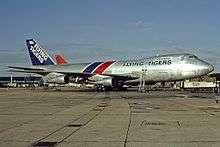Flying Tiger Line Flight 66
 N807FT, the aircraft involved in the accident, at London Heathrow Airport in 1980 | |
| Accident | |
|---|---|
| Date | February 19, 1989 |
| Summary | Controlled flight into terrain due to ATC error and crew error |
| Site | 12 km (6.5 nmi) from Kuala Lumpur |
| Aircraft | |
| Aircraft type | Boeing 747-249F |
| Operator | Flying Tiger Line |
| Registration | N807FT[1] |
| Flight origin | Singapore Changi Airport |
| Stopover | Sultan Abdul Aziz Shah Airport |
| Destination | Hong Kong[2] |
| Passengers | 0 |
| Crew | 4 |
| Fatalities | 4 |
| Survivors | 0 |
On February 19, 1989, a FedEx-owned Boeing 747-249F, operating as Flying Tiger Flight 66, crashed while flying an international cargo flight from Singapore to Kuala Lumpur, Malaysia. The aircraft impacted terrain 12 miles from the airport, resulting in four fatalities.
History
The aircraft was assigned a non-directional beacon (NDB) approach to Runway 33 at Sultan Abdul Aziz Shah Airport, Kuala Lumpur, after having flown 30 minutes from Singapore Changi Airport.[3] In descent, the flight was cleared to "Kayell" with a morse code of "KL" of which four separate points on the ground were commonly called by Malaysian ATC albeit with different frequencies. Two separate radio beacons were identically coded "KL" as well as the VOR abbreviation (Kuala Lumpur shortened to "KL") and the airport was also sometimes referred to as "KL" by local ATC (instead of the full "Kuala Lumpur"). The crew was unsure to which point they were cleared, and the cockpit voice recorder revealed that the crew argued about which radios should be set to which frequencies and which approach was actually going to be conducted. (Even in the last few moments of the flight, the captain referenced the ILS approach for runway 33 which was named as inop on the flight release and the ATIS, additionally the crew was told by ATC that the ILS approach was not available.)
ATC radioed to the flight, "Tiger 66, descend two four zero zero [2,400 ft]. Cleared for NDB approach runway three three." The captain of Tiger 66, who heard "descend to four zero zero" replied with, "Okay, four zero zero" (meaning 400 ft above sea level, which was 2,000 ft too low). The proper radio call from ATC, instead of "descend two four zero zero", should have been "descend and maintain two thousand four hundred feet". The captain read back "okay, four zero zero" where the proper read back should have been "Roger, descend and maintain four-hundred feet". The Cockpit voice recorder[4] also revealed several communication errors made by the flight crew prior to this miscommunication and a general casual nature of the Captain, who was the pilot-not-flying on this particular leg of the trip.
Numerous clear warnings were given by the on-board Ground Proximity Warning System which were all ignored entirely by the crew, and the aircraft impacted a hillside 437 ft above sea level, killing all four people on board; two pilots, a flight engineer and an aircraft mechanic. The subsequent fire burned for two days.[4]
Causes
The First Officer had complained that he did not have an approach plate in front of him and hadn't seen the approach. From a pilot's perspective, this alone would be considered the cause of the crash because the approach plate (chart) provides the pilot with the courses and minimum altitudes necessary to execute the approach without impacting terrain. The chart would have indicated the minimum descent altitude of 2,400 feet, preventing the accident. Flying an approach without referring to the approach plate is gross negligence.
Additionally, the First Officer (FO), who was the pilot flying at the time, expressed concern about conducting the NDB approach and indicated a preference for the ILS for runway 15. However, the FO was not assertive and no further action was taken. The Captain dismissed his concern saying he was familiar with the airport and the approaches.
The second officer was 70 years old and used a magnifying glass to see. A contributing factor to this accident was the non-ICAO phraseology used by Kuala Lumpur air traffic control and the Captain of the aircraft. This breakdown of communication contributed to the crew misinterpreting the instructions given. However, this particular controlled-flight-into-terrain accident ultimately resulted from a crew failure to adhere to the instrument approach procedure, poor crew resource management and poor situational awareness.[3]
Procedure changes
This accident caused the creation of the GPWS escape maneuver which all airlines now use. It further stressed the need for increased awareness and training of crew resource management techniques and standard operating procedures. This accident is used as an example of 'what not to do' by flight training organizations such as FlightSafety International. The FAA video production[4] using the original CVR transcript is still used to study the events and how to improve current techniques. Much of this information is derived from that video.
References
- ↑ "FAA Registry (N807FT)". Federal Aviation Administration.
- ↑ "Safety Recommendation A-89-022". NTSB. FAA. Retrieved 5 January 2016.
- 1 2 Accident description at the Aviation Safety Network. Retrieved on 2008-06-28.
- 1 2 3 "Aviation Video: Tiger-66 | Patrick's Aviation". Patricksaviation.com. 2008-12-22. Archived from the original on 2012-03-24. Retrieved 2012-10-15.
- Aviation Week & Space Technology 27.02.89 (24)
- Flight Int. 17-12.01.1990 (p. 44)
- ICAO Adrep Summary